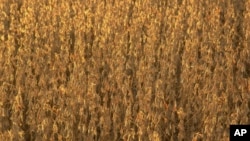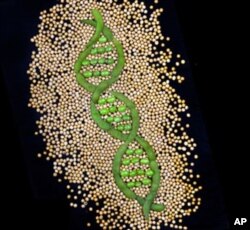The soybean has fed generations of Asians, fattened countless head of livestock and is now poised to take off as the next generation of jet fuel. Scientists have decoded the legume's genetic sequence.
First domesticated by the Chinese more than 3,000 years ago, the soybean is one of the pillars of American agriculture. About 30 million hectares of soybeans are harvested each year.
But it wasn't always so. The rise of the soybean in America is a 20th-century phenomenon.
American farmers first used soybeans for animal feed
"Something had to be grown in rotation with corn," says Scott Jackson, professor of plant genetics at Purdue University. Corn, which is also called maize, is the other pillar of American agriculture. Maize takes a lot of nutrients out of the soil. One of the virtues of the soybean plant is that it replaces those nutrients.
But for years farmers just harvested soybean plants for hay. That changed around mid-century, Jackson says, when scientists starting asking themselves, "Well, what else can we use it for?"
They discovered it was useful for feeding poultry, says Jim Hershey, executive director of the World Initiative for Soy and Human Health.
"People realized that if you fed a chicken a mixture of corn and soy, that chicken grew a lot faster," he says, "which effectively reduced the cost of raising poultry, which helped a lot of people's diets all around the world, including here in the [United] States."
Hershey says chicken went from being an occasional luxury to an everyday meal. Today, most of the world's soybeans go to feed not just chickens, but cows, pigs and even fish. Soy protein and oil also find their way into a wide variety of processed foods for people.
From animal feed to bio-fuel and beyond
But food is just the beginning. Marty Ross works for the United Soybean Board which is a U.S. trade group. He says that, in the 1930s, an auto industry pioneer found soybeans made a pretty good plastic. "Henry Ford, of course, discovered, 'You know what, I can make automobile trunk lids and fenders out of soybean oil,'" he says.
Since then, Jackson says that researchers have produced an incredible range of products made from soybeans. "Everything from crayons to jet fuel," he says. Soy-based biodiesel fuel is making its way into the market today, along with carpeting, roofing materials, inks, adhesives and more.
Experts are predicting a great leap forward for this Chinese bean. In the Jan. 14 issue of the journal Nature, Jackson and a group of scientists announced they have unraveled the genetic code of one common variety. The discovery should dramatically speed up the process of breeding better strains.
Using the genetic code to speed research on several fronts
The United Soybean Board's production chairman, Rick Stern is excited about the possibilities. "The advancement we're going to make on the production and research side of things in the next 10 years is going to rival the last 100 years," he says.
One of the first advancements researchers are working on is scanning tens of thousands of different soybean varieties, including wild relatives, to look for useful traits. Jackson says that's important because most soybeans grown in the U.S. are very similar genetically. "And that's a real problem when you're trying to overcome new insect or disease threats or pressures, or trying to breed a plant that's more water efficient, or even finding genetic variation for water production."
Jackson says having one genome in hand will make it easier to spot useful genetic variations in other strains.
Soybeans are related to a number of other important legume crops which gives plant breeders around the world a head start in improving food production, Jackson says. He adds that scientists are working with investigators around the world to leverage the investment that went into the soybean for cowpea, chick pea, pigeon pea and other beans.
Helping breeders quickly develop better varieties of all these crops will be crucial as the world population tops 9 billion by 2050 in the face of a changing climate.











